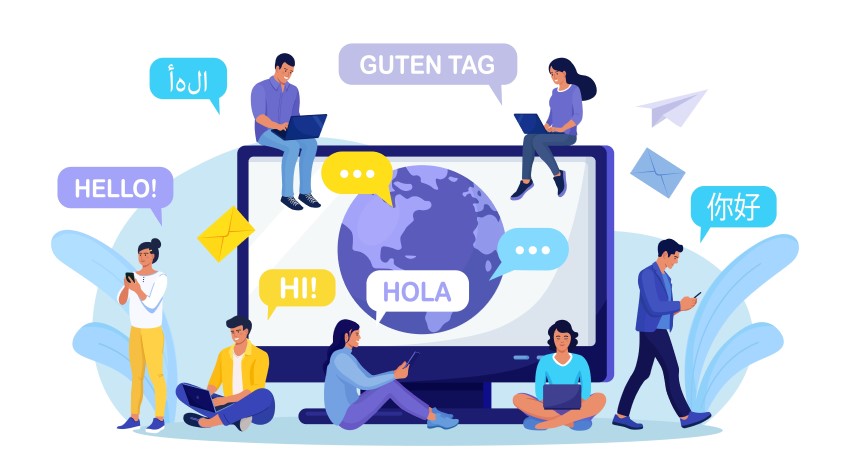In today’s globalized business landscape, multilingual employees have become an invaluable asset for organizations keen to leverage international markets. This specialized skill set goes beyond simply knowing another language: it can have a direct impact on a company’s success.
Everyone marvels at the team member who effortlessly communicates in five languages, but exactly how valuable is their skill? And is it possible to measure the return on investment (ROI) of an organization´s multilingual employees? The short answer is yes (but you need to know how).
In this article we explore the ROI of multilingualism and how leveraging the skills of multilingual employees can contribute to your organization’s growth, as well as giving it a competitive edge.
Content
How to measure the ROI of multilingual employees
To understand the value of multilingual employees it is necessary to calculate the costs associated with hiring them and compare those costs with the overall benefits they bring to the organization. Factors to consider when measuring the ROI of multilingual employees are:
- Increased customer base: Evaluate the potential impact multilingual employees have on the expansion of the customer base by determining the number of new customers or markets reached as a result of having employees who are able to communicate in multiple languages.
- Customer satisfaction and retention: Measure the effect multilingual employees have on customer satisfaction and retention rates. Analyse feedback, customer surveys and other relevant metrics to determine whether having a multilingual workforce has a positive influence on customer loyalty and churn rates.
- Sales and revenue growth: Evaluate the contribution of multilingual employees to sales and revenue growth. Determine if their language skills have resulted in increased sales, new business opportunities, or partnerships with customers from different language backgrounds.
- Competitive advantage: Consider the competitive edge associated with having multilingual employees: assess how their language skills differentiate your organization from the competition, and the impact this has on winning new business or securing contracts.
- Cost savings: Identify any cost savings associated with having a multilingual workforce. For example, if translation or interpreting services were previously outsourced, having employees who can perform these tasks in-house may result in cost savings.
- Employee productivity: Measure the impact of language skills on employee productivity. Evaluate whether multilingual employees can collaborate more effectively with colleagues, improve communication within the organization, or perform tasks that would otherwise require external language support.
- Language proficiency levels: Assess the language skills of employees and quantify their ability to communicate effectively in multiple languages; consider factors such as fluency, comprehension, and the ability to perform business tasks in different languages.
- Language training costs: Identify the costs incurred by providing language training to employees, this includes language courses, materials, and any additional resources required for the training. Digital language service providers such as Speexx offer online corporate language training with personal coaches as a convenient all-in-one solution.
Once you have collected the necessary data, you can calculate the ROI using the following formula:
ROI = (benefits – costs) / costs * 100
It’s a good idea to consider both quantitative and qualitative factors when evaluating the ROI of multilingual employees, so let’s have a closer look at why multilingual employees are crucial, and learn more about the key benefits.

Professional Development From Within - Digital Business Coaching
Learning a new language is not the only aspect of employee development. Read this whitepaper to learn more about professional development through business coaching!
Get the document

Why multilingual employees are crucial
Unless your business is confined to a very specific geographical region – a rarity in today’s globalized world – there comes a time when you´ll want to take your market overseas; this is when the need for language skills is most acute. Robert Lane Greene of The Economist points out that a list of the world’s richest economies is dominated by countries that are famously multilingual, including:
- Luxembourg
- Switzerland
- Singapore
- Scandinavian countries where English is spoken widely.
Among the key factors contributing to these countries´ success is effective communication in more than one language, which begs the question: if Swedes or Singaporians were monolingual with no significant knowledge of English, would they be as successful?
The competitive advantage of multilingual employees
What are the exact competitive advantages of hiring employees who speak multiple languages? In a highly interconnected world, having a workforce that can communicate in multiple languages offers several distinct advantages, and research confirms that organizations with multilingual employees are better positioned on many fronts. Here are 3 advantages:
- Expanding into new markets: Multilingual employees can help companies overcome language barriers when entering new markets. According to a study by Common Sense Advisory, 72.4% of consumers are more likely to buy products with information in their native language. This represents a significant opportunity for businesses to tap into non-English-speaking markets and drive growth.
- Build strong relationships: Effective communication is the foundation of successful relationships, both internally and externally. A multilingual workforce can improve collaboration and foster stronger ties with international partners, clients and customers. This advantage can lead to improved customer satisfaction, increased loyalty and, ultimately, higher revenues.
- Gain cultural insight: Language skills often go hand in hand with cultural understanding. Multilingual employees can help organizations navigate cultural nuances, customs and preferences, enabling them to tailor their products, services and marketing strategies to specific target markets. This cultural intelligence can be a decisive factor in building a brand’s reputation and gaining a competitive edge.
Multilinguism boosts employee productivity and engagement
Multilingualism not only benefits organizations externally but also internally, positively impacting employee productivity and engagement. For example, multilingual employees contribute to an average 10% increase in team productivity. Here’s how:
- Enhanced problem-solving and creativity: Research has shown that people who speak multiple languages have improved cognitive abilities, including enhanced problem-solving skills and creativity. By leveraging the multilingual skills of your employees, you can tap into their broader perspectives and innovative thinking, leading to more robust solutions and increased efficiency.
- Increased flexibility and agility: Multilingual employees can adapt seamlessly to changing circumstances, making them an asset in international collaboration, negotiation and problem-solving. Their language skills allow them to pivot quickly, resulting in improved decision-making and agility in fast-paced environments.
- Improved employee satisfaction and retention: When organizations invest in language training and the development of their employees, it signals a commitment to their growth and professional evolution. This investment not only increases employee satisfaction, but also improves retention rates.

How to Become a Leadership Grandmaster and Keep Your People
This is your way to employee retention! Read this eBook and become a master at managing people and creating a positive business culture.
Get the document

The financial impact of multilingual employees
A study by Cardiff Business School calculated that monolingual Britons lose a staggering £48 billion a year in today’s global economy simply because of a lack of language skills. So, let’s look at the financial upside of multilingualism and its potential to deliver a strong ROI:
- Increased revenue generation: Numerous studies have shown a positive correlation between language skills and revenue growth. According to a Harvard Business Review survey, companies that invest in language skills outperform their competitors by an average of 2.5%. Multilingual employees can make a significant contribution to sales expansion, customer acquisition and overall revenue generation.
- Cost savings in translation and interpretation: Relying solely on external translation and interpretation services can be expensive. By leveraging the language skills of multilingual employees, organizations can reduce outsourcing costs and streamline their communication processes. This cost-saving benefit can be particularly relevant for multinational companies with a global presence and extensive language requirements.
- Improved efficiency in international projects: Multilingual employees can play a crucial role in international projects, eliminating the need for constant translation and interpretation, and reducing the potential for miscommunication.
Which languages are worth investing in?
Now we´re familiar with the benefits of multilingual employees and how to measure their ROI, let´s analyse which languages are most worth investing in.
According to Forbes India, English and Mandarin Chinese are the most widely spoken languages in the world, followed by Spanish, French, and Arabic. With over 1.3 billion native speakers, Chinese is the most spoken language in the world and the second most used language on the Internet.
Are schools laying the foundations for multilingual employees?
Eurodice reports that in the EU, students in vocational education learn fewer languages than those in general education. In general upper secondary education, only 2.9% of students learn no foreign languages, 37.1% learn one foreign language, and 60% learn two foreign languages.
English is still a priority for most – over 90% of students in the majority of schools across Europe learn the language. More than 20 countries require students to study two foreign languages, with French, German, Spanish and Russian as the most popular after English.
To celebrate the diversity of European languages, the Council of Europe dedicates 26 September each year to languages and promotes various events across the continent. The European Day of Languages aims to highlight that “linguistic diversity is a tool for achieving greater intercultural understanding“.
Ready to build foreign language skills in your organization?
Imagine how much more efficient and effective your business would be if your employees could communicate in foreign languages with your international customers. Or how much more insight an employee would have into another market if they spoke the language and understood the culture of that market. And there is another benefit to being able to speak more than one language: according to the New American Economy, 71% of employers value language skills over college majors when hiring.
We see a strong language training program as a win-win situation for everyone involved! So, start building language skills in your organization today with Speexx!



